|
Monday, November 21, 2011
Progress Notes
The Wright family of Miller County has been featured on this webpage often since it was one of the earlier families to settle here in which many of its members played important roles in the growth and establishment of the county. You can read more about the Wright family from our website at these previous Progress Notes (photo 01).

01 Wright references on Website
Click image to view list in PDF format
A few months ago I featured the interesting autobiography of Merle Wright (photo 02), grandson of Green Lee Wright and son of Charles Wright. If you missed it you can read it at this previous Progress Notes.
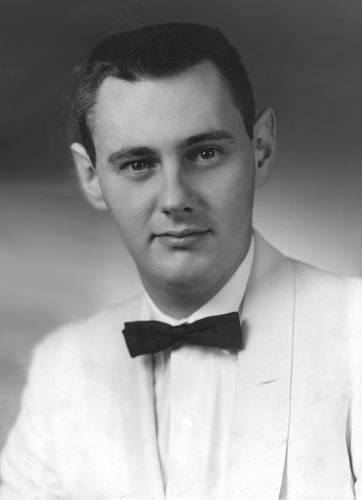
02 Merle Wright
This week I will present Merle’s biography of his father, Charles, who was one of those Miller County natives who left the area to achieve success elsewhere. Charles loved his home of origin on the little Saline Creek and came here to visit often. The narrative written by Merle is one of those which adds more detail and history about one of Miller County’s early families.
Charles Isaac Wright (photo 03)
1893-----1976
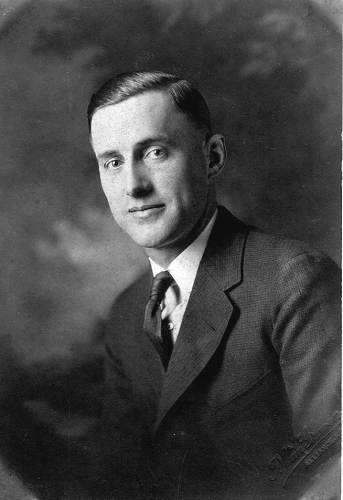
03 Charles Isaac Wright
Charles Isaac Wright was born Dec 29, 1893 at his parent’s home on the Little Saline Creek, in Miller County, Missouri, to Mary Emma (Boyce) Wright and Green Lee Wright (photo 04).
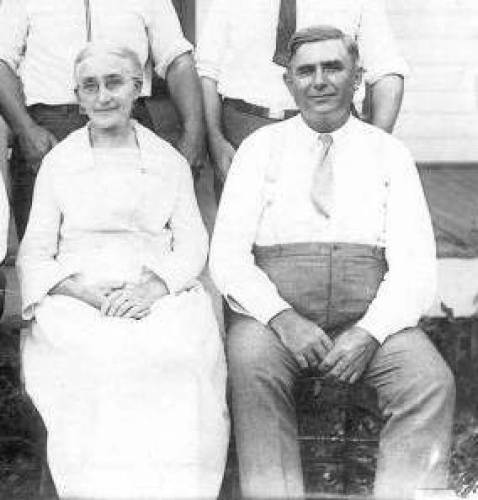
04 Mary Emma Boyce Wright and C.B. Wright, her son
Charles was the youngest of their six children (photo 05).
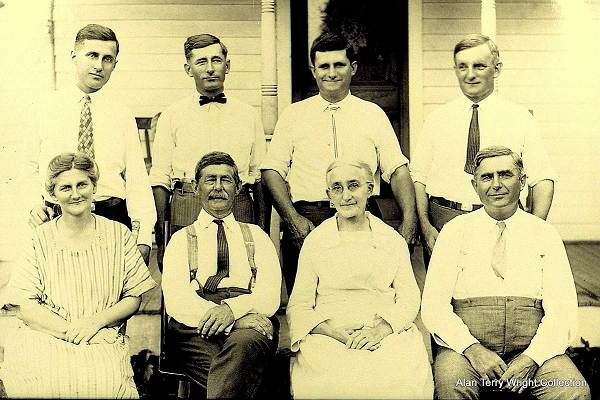
05 Green Lee Wright and Family
Note: Here is the caption for the family photo above:
At the back of the photo are left to right Charles, Homer Lee, Richard, and Otis. In the front of the photo left to right are Gertrude, Green Lee, Mary Emma Boyce Wright, and Clarence Boyce Wright.
The first known picture of him is with his father at the Wright family carding mill in 1903 as pictured in this next photo. Charles is the small boy sitting on the far right (photo 06).
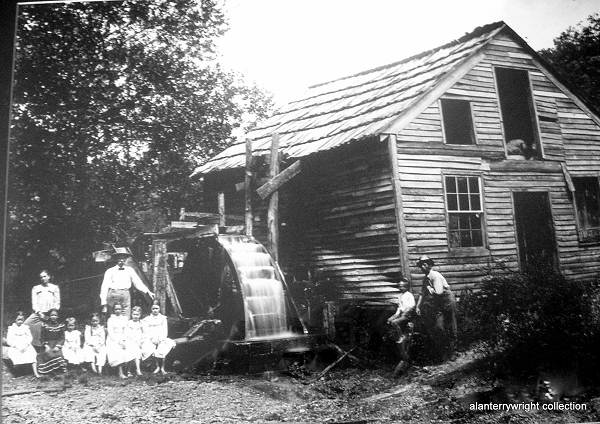
06 Wright's Carding Mill
Note: Here is the caption for that photo:
“Visitors are Billie Harrison and his Sunday school class from the Christian Church at Tuscumbia. Seated from left are (maiden names) Gardia Swanson, Gretchen Bacon, Anna McBride, Anna Clark, Hortense Swanson, Lura Clark and Maude Clark. Standing behind: Ethyl Moles and Billie Harrison. Over on right; Lee Wright and son, Charley. Photo taken in the year 1903.”
The farm and mill were on land, some of which was “homesteaded,” and some purchased outright, by Charles’ grandfather, James Lawrence Wright, and wife, Elizabeth Mace (Thompson) Wright (photo 07).
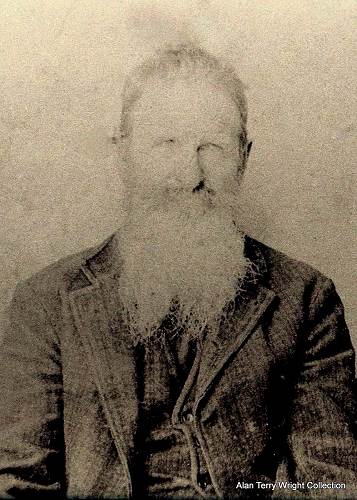
07 James Lawrence Wright 1818-1896
The Wrights had migrated from adjoining Cole County in 1856. James built a gristmill on this land that was later moved to a nearby location where it could be powered by the constant flow of a large spring (the “Wright Spring”). Years later, the mill was modified to accommodate a carding machine. James Lawrence Wright, forty-three years old at the beginning of the Civil War, served as a Lieutenant in the 42nd Enrolled Missouri Militia, a local Union “home guard” unit.
Research suggests that Charles Wright is of the seventh generation of Wrights in America, after Joshua Wright and his two brothers came to New Jersey from York, England, in about 1670. Charles’s mother, Mary Emma Boyce, was of the fifth generation that came to Pennsylvania from Doun, Ireland, in about 1767 (photo 08).
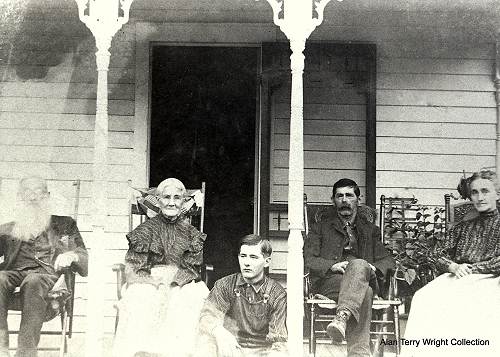
08 Richard Boyce, Mary Griffen Boyce, Homer Lee Wright, Green Lee Wright and Mary Emma Boyce Wright
Click image for larger view
Charles was known by some as "Chase," but by most as “Charlie.” He signed his name as “Chas. I. Wright,” and occasionally used his initials, “C.I.W.”
Charles attended grade school at the Wright School (named for his grandfather Wright), which was about one mile from his home, near the confluence of the little and Big Saline Creeks. His older brother, Otis, was his first teacher. Here is a photo taken in 1904 of the school class with Otis sitting in front (photo 09).
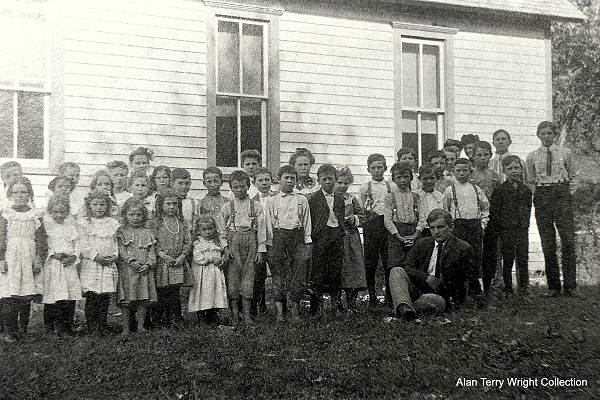
09 Wright School 1904 - Otis Wright, Teacher
Here is another photo of the school taken in 1907 (photo 10):
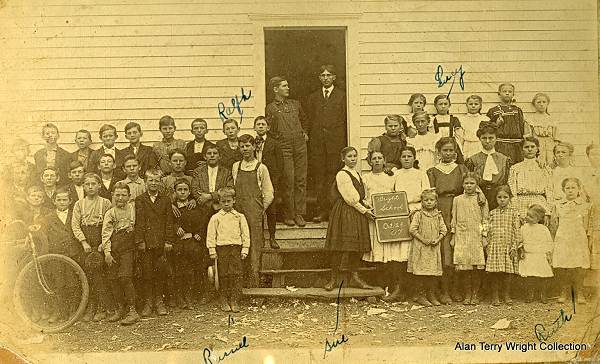
10 1909 Wright School Class in front of Building
In this photo Charles is standing to the left of Ralph Wells. You will also notice that the ink written inscription of names on the photo are children of Joshua Wells, chairman of the Anchor Milling Company at the time.
The only known major event which Charles attended in his early years was the 1904 World’s Fair in St. Louis. The ice cream cone was "invented" there and some claim that the hot dog had its beginnings at the Fair as well. Charles spoke of these marvels many times later in his life.
After primary school, Charles attended the Iberia Academy, Iberia, Missouri, for his high school work. Records show that Charles I. Wright was graduated in the class of 1915. His fellow graduates were: Otis Coan, Amy Huyer Finkham, Ray Irwin, Roscoe Rothwell, Mary Spearman, Hazel Umstead, & Clarence West. Of those classmates who lived in or returned to the Tuscumbia area:
- Hazel Umstead became a schoolteacher at Tuscumbia (photo 12).
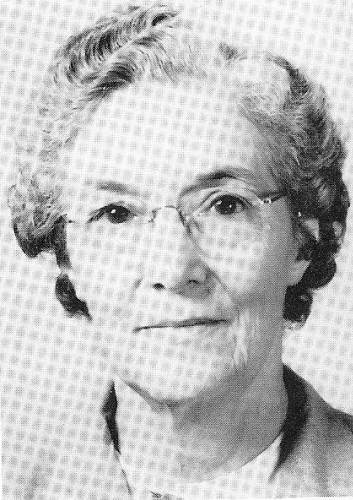
12 Hazel Umstead Humphrey
- Mary Spearman married T.C. Wright, Charles’s first cousin, a well-respected educator at Tuscumbia (photo 13).
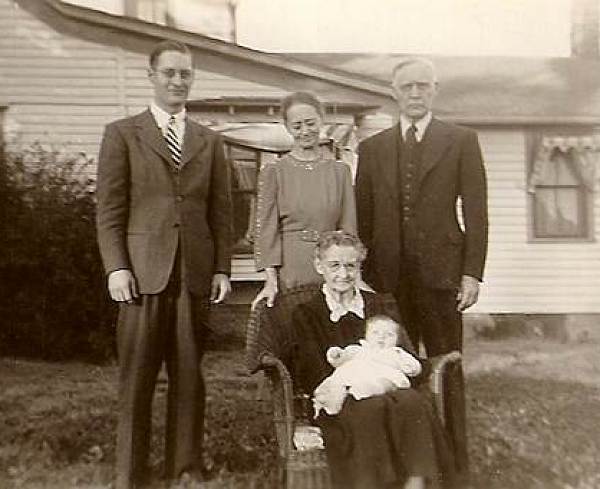
13 Back Row: T.C. Wright Jr., Mary Spearman Wright and Willard Spearman
Seated: Cynthia Hawkins holding Mary Wright
- Clarence West became an artist and married a lady from Iberia named Norma Condra (photo 14).
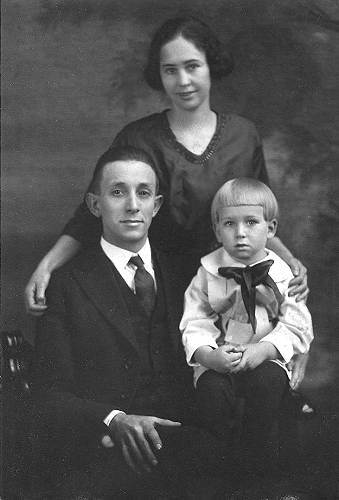
14 Clarence West and Family
- Ray Irwin earned his PhD in history and was a professor at a university. After retiring, he returned to Miller County and organized the Miller County Historical Society (photo 15).
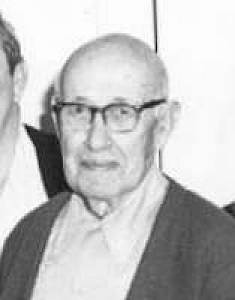
15 Dr. Ray Irwin
In the fall of 1915, Charles matriculated at Knox College, in Galesburg, Illinois and remained there for the 1916 school year.
In June of 1917, Charles was required to register for the draft for service in the U.S. armed services in WWI. That fall, he volunteered and was inducted into the U.S. Army at Jefferson Barracks, in St. Louis, on November 19, 1917 (photos 16 and 17).
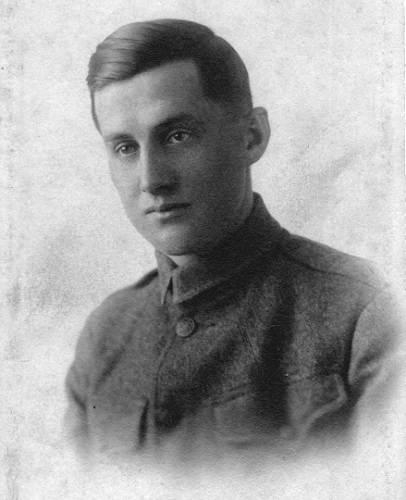
16 Charles Wright - WWI
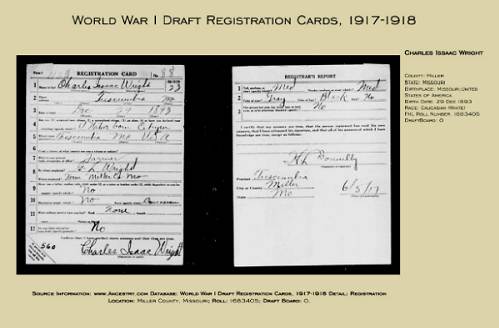
17 Charles I. Wright WWI Draft Registration
Click image to view larger version in PDF format
Charles I. Wright served this country in WWI with Battery ‘A’ of the 57th Coastal Artillery Corps with the same courage, integrity, and fairness that he portrayed throughout his life. He was sent to the fighting in France in May of 1918 and served there until January, 1919, a couple of months after the armistice ending the war was signed "at the eleventh hour, eleventh day, eleventh month," of 1918. The war that President Woodrow Wilson once declared would “make the world safe for democracy,” was over. A single letter, from “Somewhere on the Western Front,” to his brother, Homer Lee Wright, dated October, 1918, survives and is included below (photos 18, 19 and 20):
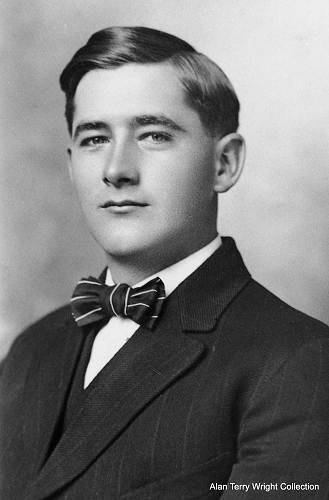
18 Homer Lee Wright
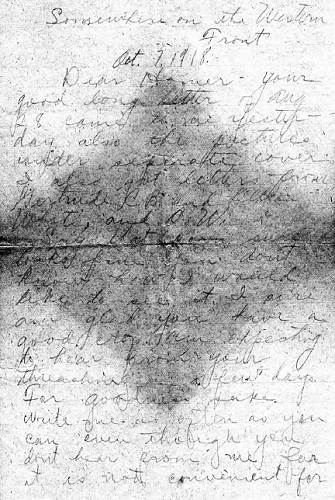
19 Charles I. Wright to Homer Wright - October 7, 1918
Click image to view complete letter in PDF format
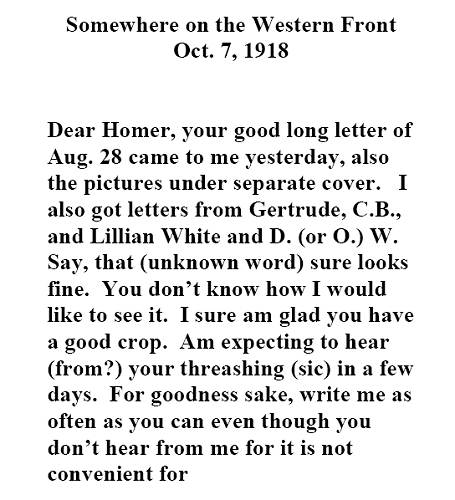
20 Charles I. Wright - WWI Letter
Click image to view complete letter in PDF format
January 2, 1919, Charles and the other 57th Coastal Artillery Corps survivors boarded the USS Huntington (The armored cruiser, “Huntington,” had been originally commissioned in 1905 as the USS West Virginia) at Brest, France and sailed for home, arriving January 14, in Hoboken, New Jersey.
Charles I. Wright was honorably discharged from service with the rank of Corporal.
Charles hoped to arrive home in secret, giving his family a big surprise. Unfortunately, neighbors spotted the “Doughboy,” duffel hoisted on his shoulder, hiking down the hill and immediately phoned the Green Lee Wright place to inform them he was on his way, “home from the wars.” A telephone had been put into the Green Lee home during Charles’ time over seas and he did not know they had one. Charles remained unhappy for a very long time about his secret being exposed.
After his return home, Charles found a job at Eldon Hardware & Lumber Company, owned by the Harvey family. This work likely got him interested in pursuing the lumber business.
Charles joined the Blue Lodge of the Masonic Order in Tuscumbia MO, Lodge #9635, and on May 7, 1920, took his 1st. degree. He obtained additional Masonic degrees during the following year. Later, Charles's wife, Pauline, joined the Order of The Eastern Star. His brother, Homer Lee Wright, was also a Mason and likely recruited Charles into the Masons.
In the spring of 1923, Charles went to Kansas City, seeking employment, where he took a job with the Wear-U-Well Shoe Company, based in Minneapolis, MN (photo 22).

22 Wear-U-Well Shoe Sign
As a traveling auditor, he would be working out of Meriden, KS, near Topeka. He evidently didn’t care much for the job, because three days later he wrote a letter while on the train from Topeka, KS to St. Joseph, MO, to his brother, Homer Lee. It said, “I will stay with them until I get something better.” He was being paid $20.00 a week, plus railroad fares and hotel bills. He asked Homer to let him know if he heard of “any job paying a $100.00 month, with a future to it.”
The next day, Sunday, April 1, 1923, he wrote another letter to Homer saying he was going to “...try and shake the Wear-U-Well Shoe people and take up the retail lumber business.” He wanted to see if a job offer from the Forest Lumber Company of Kansas City was still available, as well as offers from other lumber companies. He also commented: “I’ll have to send The Anti-Saloon League $1.50 to keep my promise good.” That "promise" remains unexplained.
Charles took the job with the Forest Lumber Company, as a traveling auditor (although he hadn’t liked the travel with the shoe company), to be based out of Alliance Nebraska. The attached letter is to Homer Lee the day he was leaving at “six bells” for Alliance, from Kansas City, to begin his new job with a starting wage of the sought-after $100.00 per month (photo 23).

23 Charles I. Wright to Homer Wright - July 16, 1923
Click image to view complete letter in PDF format
Charlie would send Homer pictures of a late spring snowfall (April 23rd) in Alliance, NE (photo 24).

24 Snow at Alliance
Click image for larger view in PDF format
Based upon the smokestacks in the picture of “The Shop,” it appears that the Alliance operations might have been a sawmill or other manufacturing facility. It was also a large lumber and building supply outlet for that part of Nebraska.
Charles soon became engaged to marry Pauline Kouns, daughter of Dr. D.H. and Lena Kouns, of Tuscumbia, MO. Little is known of their courtship except for a trip with friends to Ha Ha Tonka, a "castle" among natural wonders on the Niangua River. Charles and Pauline's Miller County, MO marriage license, dated May 24, 1924, lists his address as Alliance, NE. They were married May 25, 1924 at the Presbyterian Church in Tuscumbia (photos 25, 26 and 26a).
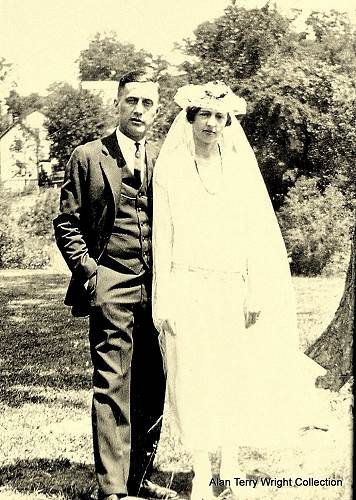
25 Charles and Pauline Kouns Wright Wedding Photo

26 Tuscumbia Presbyterian Church
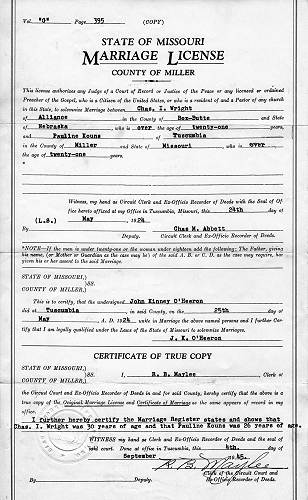
26a Marriage License
Click image for larger view
The two then returned to Alliance on the train from Eldon to start their new life together.
The population of Alliance, NE in 1920 had reached nearly 6,000 and the city dubbed itself "The Queen City of the Plains." Local boosters seem to need to give their towns regal sounding names. Centralia, Missouri, where Charles and Pauline would later settle, named itself “The Prairie Queen.” Springfield, Missouri, remains to this day “The Queen City of the Ozarks.”
After a year or more in Alliance, Charles and Pauline moved to Warren, Pennsylvania with another division of the Forest Lumber Co. He took Scottish rite work there and became a 32nd Degree Mason in Coudersport, PA. Charles and Pauline went to Niagara Falls, on a deferred honeymoon trip, while they were in the Pennsylvania area.
A couple of years after they were married, Charles bought a new car. It was a Whippet, the number two brand in popularity in the U.S. at the time, but fairly scarce in Missouri (photo 27).

27 Whippett Automobile
It was similar to a Model A Ford but was “classier,” and today would be worth many dollars. He went on to buy and own many cars in his lifetime. These included a 1935 Plymouth and other Plymouths in 1940 and 1941. After the war it was a 1948 Dodge, a 1953 Chrysler, and a 1959 Pontiac. A 1965 F-85 Olds was the last new car.
In 1929, Charles and Pauline moved to Centralia, Missouri where he took a job as Manager of La Crosse Lumber Co. They rented a nice frame bungalow at the north end of Allen Street which is the main street of Centralia. A year later they moved to the south end of Allen Street.
Sept. 1, 1933, a son was born, Merle Glen Wright, Charles and Pauline’s only child. Charles wanted to name the boy “Carl,” but Pauline, said, “No!” She deemed that name much too “German sounding,” so soon after WWI. They settled on "Merle Glen." No relatives on either side had those names. Charles and Pauline worked hard at trying to be good parents, but it should be noted that Merle was a little spoiled. It would be safe to say they reacted to child rearing emergences in a calm manner and responded accordingly (photo 28).

28 Merle Wright
In 1934, Charles and Pauline bought a seven-room house at 308 W. Sims St. on the southwestern edge of Centralia. Eight acres of pastureland came with it. The house was nearly new, having been built in 1932 for Mr. Arthur Bruton, Mayor of Centralia. The light fixtures for all the rooms matched, as they had been a gift from the citizens to the Mayor. The house had a full basement of 5 rooms and a half bath, a gas forced air furnace, and a gas hot water heater with water softener. There was a two-car garage, a barn, and other outbuildings. Most of the neighbors did not have indoor plumbing and heated their homes with a coal stove in the living area and a wood or oil cooking stove in the kitchen.
Charles had joined the Christian Church at an early age. He was very interested in his religion and taught a men's class at Sunday school in the First Christian Church of Centralia. He was also a deacon and later an elder, and served on the church board of directors. Pauline attended services at the Christian Church and saw to it that her son was exposed to the Christian religion. Centralia did not have a Presbyterian Church and she maintained her membership in Tuscumbia.
In the middle 1930’s, Charles bought a farm from one of the big insurance companies that had foreclosed on it during the Depression. It was known as the Hulen place, a piece of land of 115 acres, about one mile west of Centralia that lay between a railroad on each side and a country road on each end. He rented the farmhouse to Ervin Shelledy and family. Then he bought 40 acres about three miles northwest of town. He sold this place a few years later and bought a better 40 acre place about one mile southwest of town. It became known as “21,” likely derived from the legal description. Many times, when Pauline would be trying to hold dinner for the family, she would say, “C.I.W.” spends too much time at the "darned ole farm."
Charles learned new farming ideas from the University of Missouri Extension Service. Such as plowing deep, being 10 to 12 inches, which was new to the area and how to rotate crops such as soybeans, corn, and wheat to be able to get more production. The center of the farm had 15 to 20 acres of prairie grass, also known as “virgin” soil. The hay from prairie grass is good feed for horses. Prairie grass also provides natural cover for prairie chickens and quail that populated the area at that time.
Charles bought a used 1946 Dodge truck for the farm and used it to haul beans and corn to market, as well as prairie hay to Stephens College in Columbia. They used it to feed their show horses. Charles had a great appreciation of fine horses. He and other businessmen of Centralia organized a two day annual horse show in the late 1930’s for American Saddle Bred and other breeds, including the" road horse," otherwise known as the Missouri Foxtrotter. The year he was president of the show, his brother, Homer Lee, came to visit and attended, along with his daughter, Betty Lee. Homer and Charles were best of friends, as well as brothers, going fishing and hunting together. Charles had a Davis 12 gauge, double barreled, shotgun which had been handed down from the family years before.
Note: You can read more about the Audrain County horse show and the world headquarters of the Amercian Saddle Bred Horse Society (photo 29) located at the Audrain County museum at this previous Progress Notes.
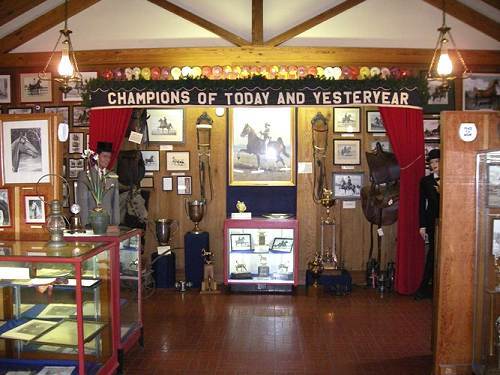
29 American Saddle Horse Museum - Mexico, Missouri
During WWII, Charles would go to Tuscumbia and help his brother, Homer Lee, with different farming projects. On one such trip, he a drove a team of white mules from morning to night named “Charlie” and “Toby.” The mules pulled a cultivator, plowing a large field of late corn. The land was in the Osage River bottom across from the Wells place where it had been flooded earlier. He worked with Homer, picking strawberries on a farm on Gum creek, to sell at market. Another year, Homer raised turkeys and Charles helped teach them to roost. Charles and Pauline tried to go to the annual Tuscumbia Picnic as often as possible in order to visit with friends of yesteryear.
Note: You can read more about the Tuscumbia Picnic and the visits of Charles and his son Merle at this previous Progress Notes.
Charles thought that rural Missouri was behind the times in building and repairing the county roads. He got elected to the Centralia Special Road District board and served on it for many years. The District helped improve “farm-to-market roads” by cutting new ditches for proper drainage and putting gravel on dirt roads for the first time. The foreman of the work crew was a Mr. Harlow who liked and respected Charles. Harlow, along with his two sons, was the work force that got Northern Boone County’s dirt roads greatly improved, coming out of the “Depression.”
Charles, Pauline and Merle traveled to Tuscumbia many times visiting his mother & father, as well as brothers, Homer Lee, Otis, C.B., and Richard, and also Pauline’s mother (photos 30, 31 and 32).
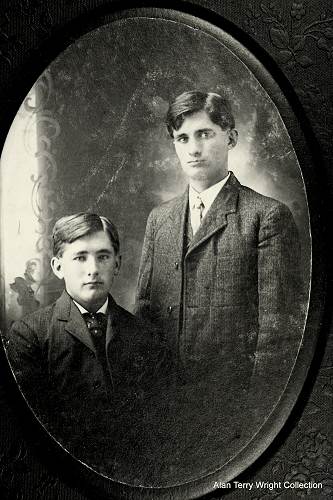
30 Homer Lee and Richard Wright
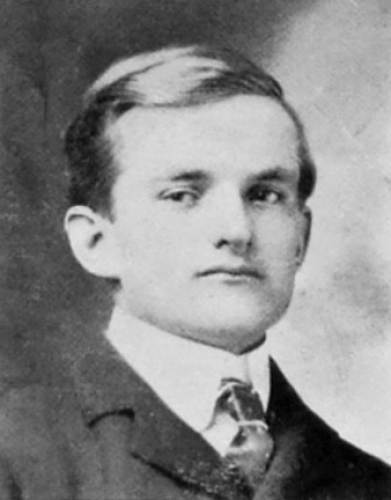
31 Otis Wright
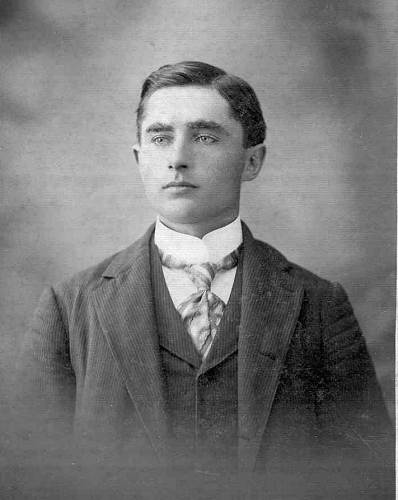
32 Clarence Wright
When traveling to Miller County, Charles’s fascination with trains caused a small detour through Jefferson City for a "must see" stop at the round-house where the steam locomotives were maintained (photo 33).
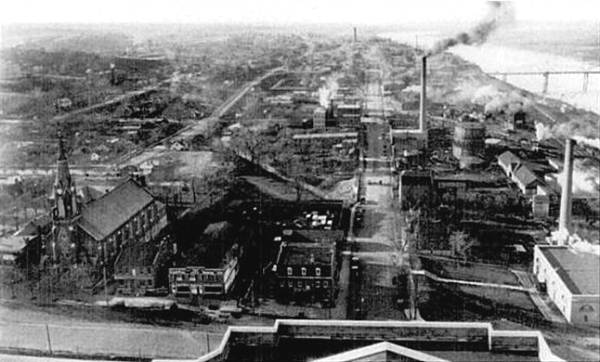
33 Jefferson City Roundhouse
At that time, one drove south across the old bridge over the Missouri River and made a sharp left turn, down the hill, to the river bottom. There it was, on the left, comprising a long semi-circular block.
Other summer vacation trips by car included a trek to the Black Hills of South Dakota when Merle was 13 years old. This trip included a visit to Alliance, NE, to see the old lumber company he worked for in the 1920’s and to visit a friend that owned and lived on a large cattle ranch. It was spring "round up" time and barbecue and ‘mountain oysters’ were served to those friends and neighbors who helped.
Another long "road trip" was with another couple to New York City, visiting the Statue of Liberty and Radio City Music Hall. Twelve-year-old Merle thought the “Rockettes” at Radio City were wonderful. He had “sukiyaki” for the first time at a Japanese restaurant. That food item was not available in Centralia, Missouri. While in New York City, the Wright family visited the office of Mr. J.C. Penny, who was from the Missouri town of Hamilton. It was a pleasant meeting and the legendary retailer told Charles to make sure that Merle went to college.
The trip included a stop in Washington D.C., seeing most of the monuments, as well as Arlington National Cemetery and the Tomb of the Unknown Soldier. Here, the family visited the grave of another fellow Missourian, General John J. Pershing, Charles’s commander in WWI. Charles thought General Pershing was a great American.
Another car trip was to south Missouri to see the major springs of Missouri, including Round, Greer, and Big Spring. The itinerary included Rockaway Beach on Lake Taneycomo, and then on to the towns of Forsythe and Hollister. Charles had an unusual love for fresh water springs. He would travel far and wide to view another one and compare it to his memory of the one with which he grew up--on the Little Saline Creek.
For other social activities, Charles and Pauline joined a men and women’s bridge club that met once a month, in alternating homes, in the evening. Pauline was very good at this game and taught Charles the fine points of being a good partner.
Charles was a big fan of the St. Louis Cardinals baseball team and listened to the radio broadcasts of the games. He and his friends took three carloads of their families on a trip to St. Louis for a game against the Brooklyn Dodgers. He had car trouble along the way, with the motor overheating from driving too fast trying to keep up with the others. This was during WWII and parts were hard to find for the repairs. The car had to remain in the garage for several days.
Charles was very much in involved in the programs of the American Legion, getting many veterans to join, and being elected to various offices, including that of Post Commander. He also assisted veterans with problems they had in dealing with the Veterans Administration.
Prior to America’s entry into WWII, Charles was against the “America First Committee,” saying the U.S. needed to give help to our allies in the name of democracy.
In the late 1930’s the State of Missouri developed a program for any and all people born in Missouri to get a birth certificate through the Bureau of Vital Statistics. Charles got his own by having his brother Clarence, who was the required sixteen years older than Charles, to affirm his date of birth. Charles helped many others obtain their proof of Missouri birth.
Charles I. Wright helped organize the Boone County Federal Savings & Loan Company. The company made home loans to citizens of Centralia, helping them buy their own home after the Depression. He was on the board of directors and became the president. He needed to know the value of homes and learned to appraise them, receiving the “big” fee of $5.00 for his work.
In 1939, Charles became a representative for Union Central Life Insurance Company, where he managed foreclosed farms by renting them back, in some cases, to the farmers who had owned them, while permitting them to continue to live on the property. He tried to get the same people, or others, to buy the farm back from the insurance company. One time he tried to sell a northern Boone County farm to a man and his family from Miller County. In the description, Charles said it was a good farm and, "didn't have a rock on it." The man said that could not be true and therefore was not interested. Later, Charles got a sales agency for Farmers Mutual Insurance Company, selling mostly auto and homeowner’s coverages.
At the beginning of WWII, Charles worked for a short time at the A.B. Chance Company in Centralia. Then he went to work for Panhandle Eastern Pipe Line Company at the Centralia booster station south of Centralia. He first did office work and record keeping, then qualified as an operating engineer.
Charles retired December 29, 1958, after 16 years of faithful service to the company (photo 36).
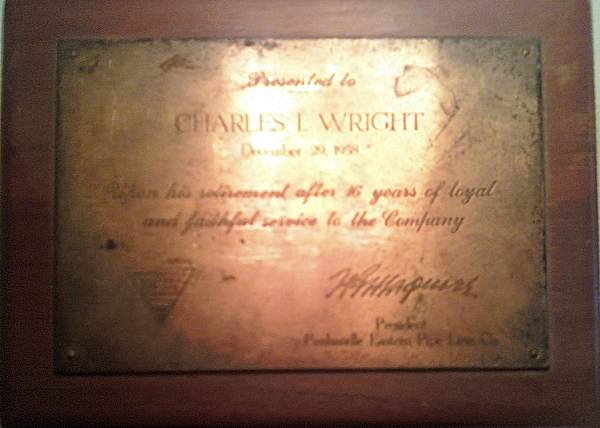
36 Retirement Plaque
Regarding politics, Charles was a strong Republican in a Democratic county. He was on the Boone County Central Republican Committee, helping candidates run for office. As such, he received the nickname of “Mr. Republican.” He sought to get people interested in voting and helped the African American people of the community to get registered and helped them vote. Although a good public speaker, he preferred being a “behind the scenes” political activist, never running for public office himself. He did not like Franklin D. Roosevelt and spent time with his brothers and sisters talking about the possible “ruination of the Country” by “New Dealers.” One of his comments was that FDR did to the U.S. what Hitler did for Germany---just in a different way. In 1940, even though it was probably a lost cause, he went to Jefferson City to hear a speech and promote the election of Wendell Willkie against Roosevelt.
After Charles’s retirement, he and Pauline traveled through most of the United States by train, and across Canada, ending up in Seattle with a visit to the World’s Fair space needle in 1962. They took another trip by car to the Wisconsin Dells into Minnesota and across Iowa.
In August of 1959, a grandchild was born, Timothy Jay, the first of two boys and one girl.
In May of 1974, Merle Wright and his family held a Golden Wedding celebration for his parents, Charles and Pauline, at their home at 308 W. Sims in Centralia. Pauline was in a nursing home with Parkinson's and was brought home for the day. Charles had a maid and cook named Bertha, who helped with this project and made it run very smoothly. Many friends and neighbors called on them that day, which pleased Charles very much.
Merle Wright likes to think of his father as a "man of letters." He corresponded with many relatives and friends. He wrote detailed reports for business and personal satisfaction, including outlines of what was to be covered in his Sunday school class. Interestingly, Charles’s brother-in-law, Clarence Kouns, a freelance writer for newspapers, was almost as strong a Democrat as Charles was a Republican. The two of them wrote many animated political comments to each other. Charles’s ability to put his thoughts on paper and state his position on a subject was outstanding--all done on a portable typewriter using the ‘hunt and peck’ method. One might say, however, that his filing system left some things to be desired, a trait that he passed on to his son, Merle.
Charles liked to read the works of many authors, such as James Whitcomb Riley’s poem, “When the Frost is on the Punkin & the Fodder is in the Shock.” Another of his favorites was Henry Wadsworth Longfellow‘s “The Song of Hiawatha.” He would attempt to recite the latter from memory. To bring the world to a local level, he read the Harold Bell Wright novel, The Shepherd of the Hills, more than once and traveled to the named places in the book near Branson, Missouri. The book’s characters and scenery probably reminded him of Miller County.
In the summer of 1972, Alan Terry Wright (photo 38a1) visited Charles I. Wright one Sunday afternoon at his home in Centralia.

38a1 Alan Wright
Twenty five year old Alan was copying old photographs of the Wright family and collecting genealogical information. Charles' father, Green Lee and Alan's dad, Garcia (Garsy) Wright were first cousins. Alan recalls that "Charlie" Wright was a small, soft spoken man, neatly dressed, whose parted white hair signified his advancing years. He had just returned from visiting his wife in a local nursing home. Mr. Wright was most gracious and proved very knowledgeable. Alan's mother had urged him to contact Mr. Wright, saying that if any living person knew the location of the graves of the first Wrights of the family to move to Missouri, "Charlie Wright would be the man to see." She was right. Mr. Wright gave Alan exact directions to an old private cemetery in an orchard just south of U.S. Highway 54 at Brazito, MO. There are interred Anthony and Nancy Wright, pioneers who came to Cole County from Pennsylvania in the 1830s. Charles's directions were impeccable and later led to restoration and fencing of the site by family members---long after Mr. Wright's death in 1976. Without Mr. Wright's assistance, this location would likely have never been found. Alan recalls that Charles Wright impressed him as an humble man, not given to bragging in any way---giving few indications of the accomplishments of his life and contributions to the community documented in this biography. Of the old school, Charles would not let Alan "go away hungry," and fixed a nourishing "bachelor" supper for the two of them before Alan's departure that evening back to St. Louis. Alan treasures the memory of having met and spent time with Charles I. Wright.
Note: Here are the photos of the Anthony Wright cemetery and home taken by Alan Wright (photos 38a - 38f):
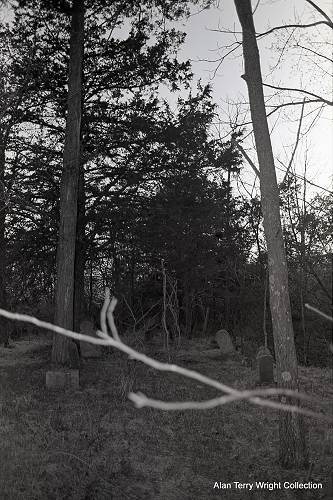
38a In 1972 or 1973, Alan Wright, following directions given by his cousin, Charles Isaac Wright, of Centralia, MO, located this old family cemetery on the Hirschman farm about 1/2 mile east of Brazito, MO. This photograph was taken a few months later, when Alan returned and excavated and stood upright the marker for Nancy C. Wright. The cemetery is on land originally patented in the 1830s by Anthony and Nancy (Cleaver) Wright. Nancy C. Wright is undoubtedly buried there and Anthony Wright, although no marker bears his name, is likely buried by her side. Other markers are for family members of subsequent owners, of German Lutheran descent.
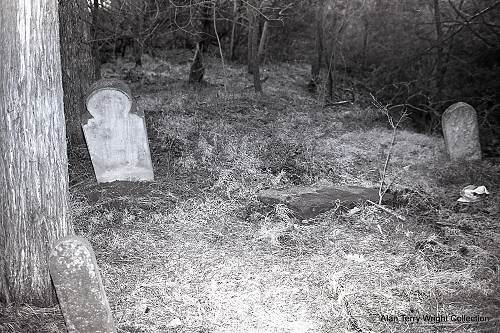
38b Upper left is the marker for Nancy C. Wright, wife of Anthony Wright. They were the parents of prominent Miller County resident, James Lawrence Wright. The roughly hewn creek limestone marker, lying flat on the ground at right, was excavated very near Nancy's marker. It had indecipherable markings on it. Perhaps it was intended as a substitute until a professional marker was obtained. Such intentions were apparently never carried out. Photo circa 1973.
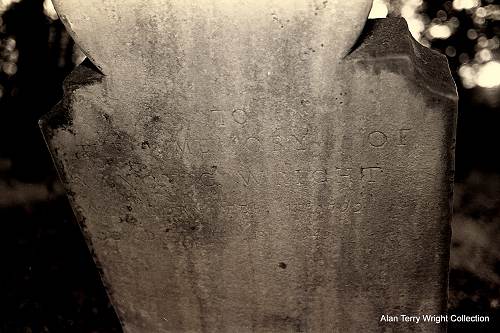
38c Inscription on Nancy C. Wright's tombstone reads: "TO THE MEMORY OF NANCY C. WRIGHT, WAS BORN 13, 1792, DE'CD AUG. 13, 1849." Photo circa 1973.
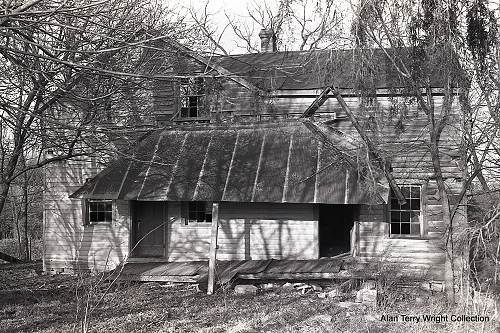
38d Very old frame house a few hundred feet from burial place of Anthony and Nancy C. Wright. A portion of it may have been the original Wright log house built in the 1830s. Photo circa 1973.
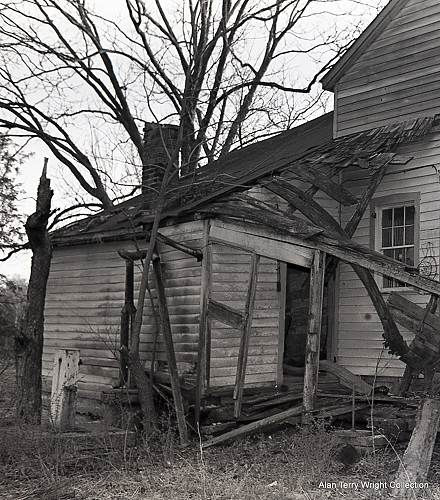
38e Abandoned and decrepit by the 1970s, this portion of a larger house may have been the back of the original Anthony and Nancy Wright house, built in the late 1830s or early 1840s. Photo circa 1973.
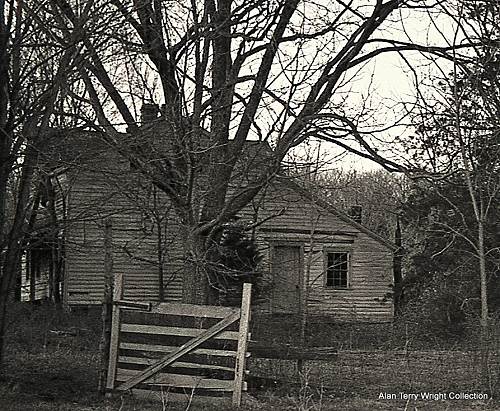
38f This portion of a large frame house on the Anthony and Nancy Wright farm may have been the original Wright residence. It is built in the "saltbox" style, with an upstairs under a steep sloping rear roof. Photo circa 1973.
And here is Alan Wright’s memory of the day he visited the cemetery to take the photos:
“Merle's dad, known to my family as "Charlie" Wright, was likely the last person alive who knew definitively where this little cemetery was and that the first Wrights of the "Tuscumbia" line in Missouri were buried there. The family owes him a debt. When I found the place, I saw no Wrights, just Germanic names of a later period, but when I turned up one stone lying face down and buried in the ground, and after brushing off the soil, saw the name "Nancy C. Wright, I was overjoyed. Because of the very shallow chiseling of the inscription, it would likely not have been readable had it not been preserved sub--surface for many of its 100+ years. As the crow flies, this farm is no more than maybe 1 1/2 miles from the Henry Thompson (Tomson) farmstead just north of Brazito. Probably no coincidence that James Lawrence Wright married Henry's daughter, Elizabeth Mace Thompson in 1842. Some 14 years later, they moved to the "Wright Spring" place in Miller County.
Some of my cousins, with their own labor and some donations, have since fenced and done some improvements on the site."
In the early 1970’s, Pauline’s Parkinson’s Disease became worse, to the effect that Charles could no longer take care of her. She lived the last few years in a nursing home. She died in March of 1976 from multiple causes. Charles had visited her every day for several years. Her death pained him very much for the rest of his life. They had been married nearly fifty-two years.
Charles I. Wright, died April 15, 1976 of heart failure at the V.A. Hospital in Columbia, Missouri. He was 83 years old. His funeral, in the First Christian Church of Centralia, overflowed with people in attendance, including prominent politicians of both parties. He is buried beside his wife in the Tuscumbia Cemetery, Tuscumbia, Missouri. His son, Merle, still believes his father's death was premature. Merle once said: "My father had a great knowledge of Miller County and the Wright family...there are many questions about many things that I regret not asking him. I know he would have had the answers---he always did" (photos 39 and 40).

39 Tuscumbia Cemetery
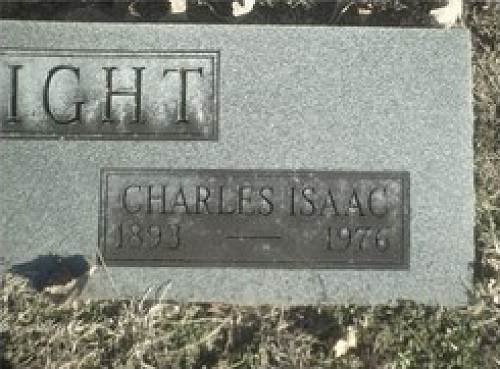
40 Charles Isaac Wright Tombstone
Written by Merle G. Wright
Only Child of Charles I. Wright and Pauline Kouns
Research by Timothy Jay Wright & Vince Alan Wright
Grandsons of Charles I. Wright
Pictures and Text Edits by Alan Terry Wright
Second Cousin of Charles I. Wright
I want to thank Merle and Alan Wright for their help in organizing this biography of Charles Isaac Wright, grand son of James Lawrence Wright, the original pioneer of the family to come to Miller County. One of the interesting aspects of this narrative to me was the love Charles and Pauline had for Miller County which drew them back here for many visits. Of course, both of them were raised here and had many friends and relatives to visit. Pauline’s father, Dr.Douglas Horn Kouns, practiced in Miller County more than fifty years. You can read his story at this previous Progress Notes.
James Earl Thompson was raised not far from where Charles Isaac Wright was born and raised (photo 41).
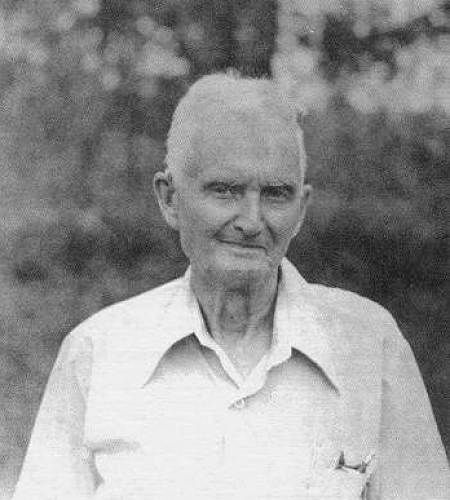
41 James Earl Thompson
In fact, both men were born the same year, 1893. James was a musician, poet, and author during his lifetime and artist as well. I wrote about him several years ago at this previous Progress Notes.
The reason for remembering him now is that he wrote a short essay in 1978 about his memories of the old Wright Carding Mill when he went there once with his father when he was five years old. Copied below is that narrative:
Recalls Trip to Old Water Mill (photo 42)
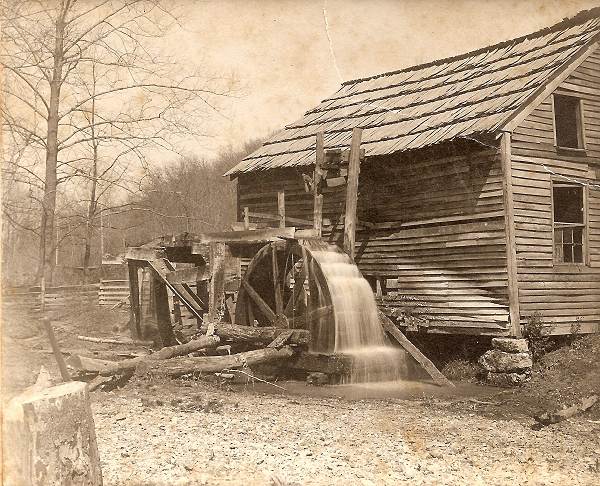
42 G.L.Wright Grist Mill at Wright Spring on the Little Saline Creek
James Earl Thompson
Published ~1978
Publication unknown
When I was a small boy, I recall one May day my father had sheared the sheep. After he had bundled the wool all up, he tied it on the back of the buckboard. He then hitched the old Sealum (our horse) up to the buckboard, got me up in the seat beside him, and we took off for the old water mill (carding machine). It was located about three miles north of Tuscumbia on the Little Saline Creek, and was owned by Green Lee Wright and his sons.
When we got there, it was an exciting and thrilling sight to me to see the water pouring over the big wheel, turning it. And the spring had been dammed up causing it to form a pool that looked to be 8 or 10 feet deep, and had bass swimming around in it. In the old water mill there was a grist mill upstairs and a carding mill below. The wool was carded or combed out nice and then made into rolls. The rolls, in turn, were taken home and spun into yarn.
Green Lee Wright started operations here several years before the turn of the century. And the old mill was closed down in the year of 1906.
In the autumn of 1905, there came a big rise in the creek; it damaged the old water mill by washing out a big hole under the wheel causing a lot of drift and debris between the mill and spring. This was known as the “pumpkin rise” and was remembered by that name for years. There were pumpkins scattered everywhere. You could see them on top of drifts and along the edge of where the high water had been.
The next year Green Lee Wright engaged Tom Harrison, and the mill was run by steam for a year by Tom’s thrashing steam engine, but was closed down completely in 1906. A few years later the old water mill was razed, and has now passed into history many years ago. The burrs of the old mill that ground the grain are encased in the front wall of the Anchor Milling Company of Tuscumbia (photo 43).

43 Mill Stone in Building Wall
Although the old mill passed into history many years ago, yet in my mind I still have a mental picture of the old water mill and the way the place looked to me the day I was there with my father when I was a five year old boy in the year 1898, some 80 years ago. I can still see the old mill house, a one and one half story rustic building standing there in the trees by the spring…and the spring sending forth a sluice of water down a trough to the big wheel that powered the machinery…and my father standing at the door entrance talking to Green Lee Wright…And then there was old Sealum hitched to the buckboard and tied to an apple tree near by. With all this in mind, it gives me a nostalgic feeling and brings back fond memories of a bygone day.
The old water mill has come and gone, and the ones who operated it have also come and gone; but the big spring is still there, as big and powerful as ever boiling up from the ground and sending off a fount of sparkling water to gladden all living things. As it goes murmuring on and on, it tends to echo the words of Alfred Tennyson. In his poem, “Song of the Brook,” which reads “Men may come and men may go, but I go on forever.”
That’s all for this week.
 Joe Pryor
Previous article links are in a dropdown menu at the top of all of the pages.
|

